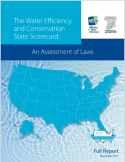Water Efficiency and Conservation State Scorecard

The Alliance for Water Efficiency (AWE) and the Environmental Law Institute (ELI) have released a five-year update to the 2012 Water Efficiency and Conservation State Scorecard: An Assessment of Laws and Policies. As with the 2012 State Scorecard, the 2017 update reviewed, scored, graded states for laws supporting water conservation and efficiency. In addition, the 2017 report added a new component for climate resiliency planning and performed a parallel evaluation, scoring, and grading process.
Though based on a 16-question survey, the 2017 update is an expansion of the 2012 edition; the underlying survey includes three new questions and a series of sub-questions for more complex topic areas. The goal of these changes was to develop a deeper understanding of legal frameworks supporting water conservation and efficiency, and climate resiliency planning. The topic areas addressed by the 2017 survey are: water loss control, consumptive use standards for appliances and fixtures, water conservation and drought planning, funding sources other than State Revolving Funds for urban conservation programs, technical assistance offerings, and customer metering, volumetric billing, and conservation-oriented rate structure requirements.
For the climate resiliency planning component, a three-question survey was used to explore what basic legal requirements obligate states to actively prepare for climate adaptation, prioritization of climate-related challenges, and the implications for water and wastewater utilities. The climate resiliency survey also included some sub-questions in order to fully understand legal parameters around critical base steps.
In all, the surveys produced more than a thousand data points which were all individually reviewed and verified. A draft of the report was made available for public comment in December 2017. All comments were responded to.
While the findings reflect some significant progress, in particular around water loss control and drought preparedness, they also clearly identify which critical areas need more work and which states have a lot of opportunity for improvement. This work was largely undertaken to support and motivate planners, policy makers, and water professionals in improving their state’s approach to managing fresh water resources and resiliency planning. Complete breakouts of state-by-state scores and grades are available in the report and in the supplemental state-by-state materials.
AWE has also released several supplements based on data collected by the 2017 State Scorecard team. The first supplement, "State-Level Water Efficiency and Conservation Laws in the Colorado River Basin," can be found here. The second supplement, "State-Level Water Loss Laws in the United States," can be found here.
AWE and ELI are grateful for partial support for this important work from the Turner Foundation. ![]()
If you are interested in the initial, 2012 Water Efficiency and Conservation State Scorecard: An Assessment of Laws and Policies, contact us to request a copy.





